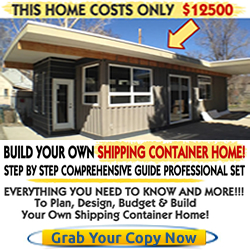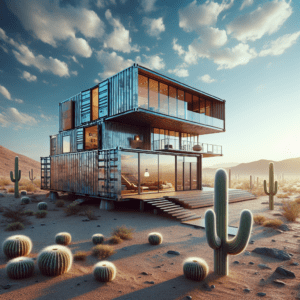
Navigating Broward County’s Regulations for Shipping Container Extensions
Expanding your home in Broward County with a shipping container can be a smart move. It’s innovative, eco-friendly, and can save you a bundle. But before you start dreaming about your new space, you need to understand the local rules. Let’s break down the regulations, zoning laws, and permits to make sure your container extension doesn’t hit any snags.
My Favorite Container Homes Resource
I compared the top 3 Container Home Guides
to discover the ultimate resource!
See my top recommendation here
Key Takeaways: Article-at-a-Glance
- Zoning laws in Broward County will affect where and how you can build your shipping container extension.
- Permits are a must-have for container extensions, and knowing the process can save you time and stress.
- Special provisions may apply to shipping container extensions, so it’s essential to do your homework.
- If you hit a roadblock with permits, there are clear steps you can take to address the issue.
- Partnering with the right professionals can streamline your project and keep you compliant with all regulations.
Understanding Zoning Laws
Zoning laws are like the rulebook for building in your community. They tell you what you can build and where. In Broward County, these rules are in place to keep things orderly and safe. You wouldn’t want a factory popping up in the middle of a residential neighborhood, right? The same goes for your container extension. You’ve got to play by the rules.
Identifying the Right Zone for Your Container Extension
Each part of Broward County is zoned for different uses: residential, commercial, industrial, and so on. Your first step is to find out the zoning designation for your property. This info is key because it dictates whether you can build a container extension and what kind of hoops you’ll need to jump through. You can usually find this information on the county’s website or by giving them a call.
Special Provisions for Shipping Container Extensions
Shipping container extensions are a bit unique. They’re not your typical brick-and-mortar addition. So, Broward County might have special provisions just for them. These could cover how the container must be anchored, insulated, or modified. It’s crucial to know these specifics upfront to avoid costly changes down the line.
Securing the Necessary Permits
Permits are your golden ticket to start building. They’re the county’s way of giving your project the thumbs up. Without them, you’re stuck. But don’t worry, getting permits is a process, and like any process, it’s all about following the steps.
Step-by-Step Process to Obtain Construction Permits
Here’s the deal: to get your permits, you’ll need to submit some paperwork. This usually includes your building plans, a site plan, and maybe some additional details about your property. Once you’ve got everything together, you’ll submit it to the county’s building department. Then, it’s a waiting game. They’ll review your plans, make sure everything’s up to code, and get back to you with an answer.
Handling Setbacks: What to Do If Your Permit Is Denied
Getting a ‘no’ on your permit application can be a bummer, but it’s not the end of the road. First, find out why it was denied. The county will give you the reasons, and that’s your roadmap for what to fix. Maybe your plans need a tweak, or there’s an issue with the site. Whatever it is, address the concerns, make the necessary changes, and resubmit. Persistence is key.
Remember, it’s all about staying informed, following the rules, and adapting when needed. With the right approach, your shipping container extension can become a reality, adding value and space to your home in Broward County.
Building Code Compliance for Container Extensions
When you’re turning a shipping container into your new den, home office, or extra bedroom, you’ve got to think about more than just where it’ll sit on your property. Building codes are a big deal—they’re like the rulebook for safe construction practices. In Broward County, these codes ensure your container extension is not just cool but also safe and sturdy.
Structural Integrity Standards
Shipping containers are tough. They’re designed to handle heavy loads and rough seas. But when you modify them for living space, you’ve got to make sure they stay tough. This means following the standards for structural integrity. You’ll need to consider how cutting openings for windows or doors can affect the container’s strength and what reinforcements you’ll need to add. It’s like making sure your container can stand up to a big, bad wolf trying to blow it down.
Electrical and Plumbing Code Requirements
Unless you’re planning to live like a caveman, you’ll want electricity and plumbing in your container extension. This is where things can get tricky. You need to follow the electrical and plumbing codes to a T. That means proper wiring, no overloaded circuits, and plumbing that won’t leak or back up. It’s all about making sure that when you flip a switch or turn a faucet, everything works perfectly and safely.
Professionals You’ll Need on Your Team
Let’s face it, unless you’re a jack-of-all-trades, you’ll need some pros to help turn your container dream into a reality. These folks have the know-how to navigate the regulations, codes, and any curveballs your project might throw.
Selecting a Knowledgeable Contractor
Finding the right contractor is like finding a new team member for a heist movie. You need someone with the skills, experience, and a good track record. They’ll manage the nitty-gritty details of construction and make sure your extension is built to last. Plus, they’ll handle the heavy lifting with the county’s building department, which is a huge bonus.
Consulting the Experts: Architects and Planners
Architects and planners are your visionaries. They’ll take your ideas and turn them into actual, buildable plans. They know how to design for both style and function, making sure your container extension looks great and feels like home. Plus, they’re wizards with the zoning and building codes, which means fewer headaches for you.
Laying the Foundation: Shipping Container Building Basics in Broward

Okay, so you’ve got your plans, your permits, and your team. Now it’s time to get down to the nitty-gritty: the foundation. Believe it or not, the foundation is one of the most important parts of your container extension. It’s what keeps your container stable and level, so don’t skimp on this step.
The Importance of a Level Foundation
Imagine setting up a pool table on a sloped floor. No matter how good you are, those balls are going to roll all over the place. The same goes for your container. If the foundation isn’t level, you’ll have doors that won’t close, uneven floors, and a whole host of other problems. A solid, level foundation means a stable container and a happy you.
Site Preparation Tips
Before your container touches the ground, you’ve got to prep the site. This means clearing any debris, ensuring the ground is compacted, and it’s as flat as a pancake. You might need to bring in some fill dirt to level things out or even out the high spots. Think of it like prepping a canvas before painting – the better the prep, the better the end result.
Choosing Between Concrete Slabs or Pier Foundations
Now, let’s talk about what your container will sit on. You’ve got two main choices: a concrete slab or pier foundations. Concrete slabs are like a solid rock for your container to sit on. They’re strong and stable, but they can be pricey and permanent. Pier foundations, on the other hand, are like stilts that hold up your container. They’re cheaper and less invasive to the land, but they need to be done right to keep your container level and secure.
Adapting Containers for Residential Use
Shipping containers are made for the high seas, not necessarily high comfort. To make one feel like home, you’ll need to insulate it, add some windows for natural light, and cut out space for doors. It’s like giving the container a makeover so it can start its new life as part of your home.
Incorporating Design Features for Comfort
Comfort is key when you’re adapting a container for living.
Customizing for Climate and Location
Your container needs to suit your climate. In Broward County, that means handling heat and the occasional storm. You’ll want to consider things like reflective paint to keep the sun at bay, proper sealing to keep water out, and maybe even some hurricane straps for those stormy months. It’s all about making your container tough enough to handle what Mother Nature throws at it.
Maximizing Your Investment: The Pros of Container Extensions
Container extensions aren’t just a trendy choice; they’re smart for your wallet and the planet. They can add value to your home and give you that extra space you’ve been dreaming of without the same cost or environmental footprint as traditional construction.
Eco-Friendly and Sustainable Choices
Containers are like the poster child for recycling. Instead of letting them rust away after their shipping days are over, you’re giving them a new lease on life. Plus, they require fewer building materials, which means less waste. And if you get really into it, you can add solar panels or a green roof to make your container extension even more sustainable.
Cost-Effective Solutions for Expanding Your Space
When it comes to expanding your home, container extensions are a wallet-friendly option. They’re generally less expensive than building from scratch because they’re already a built structure – you’re just tweaking it to make it livable. Plus, they can be faster to set up, which means you’re saving on labor costs too. It’s like getting a custom addition without the custom-built price tag.
Comparing Costs to Traditional Extensions
Let’s talk numbers. Traditional home extensions can cost a pretty penny. We’re talking about a range of expenses, from materials to labor. Container extensions, however, are a different story. Since the main structure – the container – is already there, you’re cutting down on a lot of the building materials. And because they’re simpler to modify and quicker to install, labor costs can be significantly lower. It’s like choosing between a tailor-made suit and a high-quality off-the-rack option that fits just as well after a few tweaks.
Flexibility and Scalability of Container Additions
One of the coolest things about container extensions is their Lego-like nature. Need more space? Stack another container on top or add one to the side. The modular design means you can expand your space as your needs grow. It’s like having a home that grows with your family or adapts as your home office needs change. Plus, if you ever move, you can take your container with you. Talk about flexibility!
FAQ – Frequently Asked Questions

Do I need a permit to place a shipping container on my property in Broward County?
The short answer is yes. Just like any other structure, you need to get the green light from the county before bringing in a shipping container. It’s all about ensuring safety and making sure your new addition meets all the necessary codes and regulations. So, before you get too far into planning, make sure you check in with the local building department to find out what’s required. It’s a crucial step to making your container extension a success.
How does zoning affect where I can place my container extension?
Zoning is like a community’s game plan for building and development. In Broward County, zoning laws determine the types of structures that can be built in specific areas. So, for your container extension, zoning laws will dictate where on your property it can be placed, how large it can be, and sometimes even what colors or materials you can use. It’s crucial to check these regulations before you start, as they can seriously impact your project’s location and design.
Can I live in a shipping container home in Broward County?
Yes, you can live in a shipping container home in Broward County, but there’s a catch: it has to meet the same building codes and standards as any other residential structure. This means proper insulation, ventilation, electrical wiring, and plumbing. It’s not just about slapping together a trendy tiny home; it’s about creating a safe, livable space that respects the rules and regulations of the county.
What are the structural requirements for a container when used as an extension?
When a shipping container becomes part of your home, it needs to be up to the job. This means it must meet specific structural requirements to ensure it’s safe and sound. The container must be able to support its own weight plus any additional loads from people, furniture, and even snow if you have a flat roof. It should also be properly anchored to the foundation to withstand high winds, especially during those notorious
How can I find a contractor experienced in shipping container modifications?
Finding the right contractor is like finding a needle in a haystack, but there’s a trick to it. Start by looking for contractors who specialize in alternative housing or have experience with modular or prefab homes. You can also check out online portfolios and reviews, or ask for recommendations from people who’ve done similar projects. When you find potential candidates, don’t be shy to ask for references and photos of past projects. A contractor with the right experience will be proud to show off their work and will be excited to take on your container project.
As we wrap up, remember that





